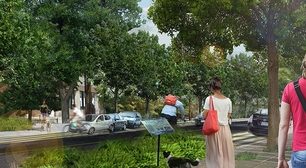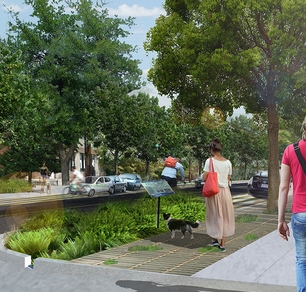The Nitsch Engineering team’s design for the DC Water Green Infrastructure Challenge has been selected as one of the winners of the planning and design phase of the competition. Working in partnership with Urban Rain|Design, Nitsch Engineering’s proposal for Kennedy|Greened: A Neighborhood Green Street Project includes six green infrastructure strategies that can be replicated throughout urban corridors across the District of Columbia. The design competition is now moving into Phase II, which will involve more in-depth design to determine which of the winning designs will enter construction.
The DC Water Green Infrastructure Challenge asked firms to design innovative solutions that absorb stormwater before it enters the combined sewer system. To meet this goal, Nitsch Engineering and Urban Rain|Design proposed improvements for Kennedy Street that integrate six different landscape and stormwater strategies: new street trees, lawn conversion, pavers with Landscape Infiltration Gaps (LIGs), stormwater curb extensions, grated landscapes, and sub-surface storage/infiltration. Environmental art installations by artist Stacey Levy integrate and draw attention to these functional stormwater features, raising awareness of stormwater movement, treatment, and storage. The design further promotes “complete street” concepts by using curb bump-outs, sidewalk crossings, sharrows, and boardwalks to create a streetscape that is safe and comfortable for pedestrians, bicyclists, and motorists.
“We anticipate that our plan for Kennedy Street will eliminate 545,000 gallons of stormwater from entering the combined sewer system annually, will improve water quality, and will minimize urban heat island effects,” said Nicole Holmes, PE, LEED AP BD+C, Nitsch Engineering’s Green Infrastructure Project Manager. “Just as important, our design will benefit the community by raising awareness and advocacy of green infrastructure, and by creating a shared street that is safer and more pleasant for all roadway users: public transit vehicles, automobiles, bicycles, and pedestrians.”
The team includes Nitsch Engineering as the design engineer and principal consultant; Urban Rain|Design as the landscape architect; Stacy Levy as the artist; and Raymond Papa as the graphic designer. To view the team’s submission, as well as those of the other six winners, visit http://dcwater.com/greenchallenge. To view a video that summarizes the Nitsch Engineering team’s proposed design, visit http://youtu.be/El5-m-sPmJk.
About Urban Rain|Design
Urban Rain|Design (www.urbanraindesign.com), founded in 2012 by nationally award-winning landscape architect Kevin Robert Perry, provides green infrastructure visioning, planning, and technical design assistance for communities throughout the United States. The firm collaborates with diverse design teams to develop simple and elegant techniques to retrofit the urban fabric with sustainable stormwater management.
About DC Water
The District of Columbia Water and Sewer Authority (DC Water) (www.dcwater.com), created in 1996 by the District government and Congress, is one of the largest water and sewer utilities on the East Coast, serving a regional area of 725 square miles, and providing drinking water and wastewater collection and treatment to residential, commercial, and governmental users in the District of Columbia, Maryland, and Virginia. In 2005, DC Water developed a Long Term Control Plan (LTCP) for Combined Sewer Overflow (CSO) control, highly dependent on a tunnel system for storing and conveying combined sewage for treatment. In 2012, DC Water, US EPA, and the District of Columbia signed the Green Infrastructure Partnership Agreement; the agencies are exploring a revision to the LTCP that incorporates more green infrastructure. The Green Infrastructure Challenge demonstration projects, once constructed, will help inform the green infrastructure implemented within the District. DC Water has committed $1 Million to the the Green Infrastructure Challenge design competition.


